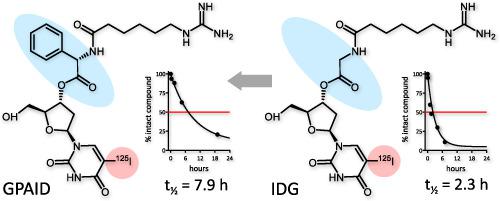当前位置:
X-MOL 学术
›
J. Label. Comp. Radiopharm.
›
论文详情
Our official English website, www.x-mol.net, welcomes your feedback! (Note: you will need to create a separate account there.)
Radiolabeled (R)-(-)-5-iodo-3'-O -[2-(ε-guanidinohexanoyl)-2-phenylacetyl]-2'-deoxyuridine: a new theranostic for neuroblastoma
Journal of Labelled Compounds and Radiopharmaceuticals ( IF 1.8 ) Pub Date : 2020-03-19 , DOI: 10.1002/jlcr.3836 Zbigniew P Kortylewicz 1 , Don W Coulter 2 , Guang Han 3 , Janina Baranowska-Kortylewicz 4
Journal of Labelled Compounds and Radiopharmaceuticals ( IF 1.8 ) Pub Date : 2020-03-19 , DOI: 10.1002/jlcr.3836 Zbigniew P Kortylewicz 1 , Don W Coulter 2 , Guang Han 3 , Janina Baranowska-Kortylewicz 4
Affiliation

|
Neuroblastoma, the most common extracranial solid tumor in children, accounts for nearly 8% of childhood cancers in the United States. It is a disease with pronounced clinical and biological heterogeneities. The amplification of MYCN, whose key tumorigenic functions include the promotion of proliferation, facilitation of the cell's entry into the S phase and prevention of cells from leaving the cell cycle, correlates with poor prognosis. Patients with a high proliferation index disease have low survival rates. Neuroblastoma is one of the most radioresponsive of all human tumors. To exploit this radiosensitivity, radioactive guanidine (R)-(-)-5-[125 I]iodo-3'-O-[2-(ε-guanidinohexanoyl)-2-phenylacetyl]-2'-deoxyuridine (9, GPAID) was designed. This compound enters neuroblastoma cells much like meta-iodobenzylguanidine (MIBG). Additionally, it co-targets DNA of proliferating cells, an attribute especially advantageous in the treatment of MYCN-amplified tumors. GPAID was synthesized from the trimethylstannyl precursor with an average yield of >90% at the no-carrier-added specific activities. The norepinephrine transporter-aided delivery of GPAID to neuroblastoma cells was established in the competitive uptake studies with nonradioactive MIBG. The intracellular processing and DNA targeting properties were confirmed in the subcellular distribution experiments. Studies in a mouse model of neuroblastoma demonstrated the therapeutic potential of GPAID. The tin precursor of GPAID can be used to prepare compounds radiolabeled with SPECT- and PET-compatible radionuclides. Accordingly, these reagents can function as theranostics useful in the individualized and comprehensive treatment strategies comprising treatment planning and the assessment of tumor responses as well as the targeted molecular radiotherapy employing treatment doses derived from the imaging data.
中文翻译:

放射性标记的 (R)-(-)-5-iodo-3'-O -[2-(ε-guanidinohexanoyl)-2-phenylacetyl]-2'-deoxyuridine:一种用于神经母细胞瘤的新型治疗诊断剂
神经母细胞瘤是儿童最常见的颅外实体瘤,在美国占儿童癌症的近 8%。它是一种具有明显临床和生物学异质性的疾病。MYCN 的主要致瘤功能包括促进增殖、促进细胞进入 S 期和阻止细胞离开细胞周期,其扩增与不良预后相关。具有高增殖指数疾病的患者存活率低。神经母细胞瘤是所有人类肿瘤中最具放射反应性的肿瘤之一。为了利用这种放射敏感性,放射性胍 (R)-(-)-5-[125 I]iodo-3'-O-[2-(ε-guanidinohexanoyl)-2-phenylacetyl]-2'-deoxyuridine (9, GPAID ) 被设计。这种化合物很像间碘苄基胍 (MIBG) 进入神经母细胞瘤细胞。此外,它共同靶向增殖细胞的 DNA,这一特性在治疗 MYCN 扩增的肿瘤中尤其有利。GPAID 是由三甲基甲锡烷基前体合成的,在不添加载体的比活性下,平均产率 >90%。GPAID 向神经母细胞瘤细胞的去甲肾上腺素转运蛋白辅助递送是在非放射性 MIBG 的竞争性摄取研究中建立的。在亚细胞分布实验中证实了细胞内加工和 DNA 靶向特性。对神经母细胞瘤小鼠模型的研究证明了 GPAID 的治疗潜力。GPAID 的锡前体可用于制备用 SPECT 和 PET 兼容的放射性核素进行放射性标记的化合物。因此,
更新日期:2020-03-19
中文翻译:

放射性标记的 (R)-(-)-5-iodo-3'-O -[2-(ε-guanidinohexanoyl)-2-phenylacetyl]-2'-deoxyuridine:一种用于神经母细胞瘤的新型治疗诊断剂
神经母细胞瘤是儿童最常见的颅外实体瘤,在美国占儿童癌症的近 8%。它是一种具有明显临床和生物学异质性的疾病。MYCN 的主要致瘤功能包括促进增殖、促进细胞进入 S 期和阻止细胞离开细胞周期,其扩增与不良预后相关。具有高增殖指数疾病的患者存活率低。神经母细胞瘤是所有人类肿瘤中最具放射反应性的肿瘤之一。为了利用这种放射敏感性,放射性胍 (R)-(-)-5-[125 I]iodo-3'-O-[2-(ε-guanidinohexanoyl)-2-phenylacetyl]-2'-deoxyuridine (9, GPAID ) 被设计。这种化合物很像间碘苄基胍 (MIBG) 进入神经母细胞瘤细胞。此外,它共同靶向增殖细胞的 DNA,这一特性在治疗 MYCN 扩增的肿瘤中尤其有利。GPAID 是由三甲基甲锡烷基前体合成的,在不添加载体的比活性下,平均产率 >90%。GPAID 向神经母细胞瘤细胞的去甲肾上腺素转运蛋白辅助递送是在非放射性 MIBG 的竞争性摄取研究中建立的。在亚细胞分布实验中证实了细胞内加工和 DNA 靶向特性。对神经母细胞瘤小鼠模型的研究证明了 GPAID 的治疗潜力。GPAID 的锡前体可用于制备用 SPECT 和 PET 兼容的放射性核素进行放射性标记的化合物。因此,



























 京公网安备 11010802027423号
京公网安备 11010802027423号